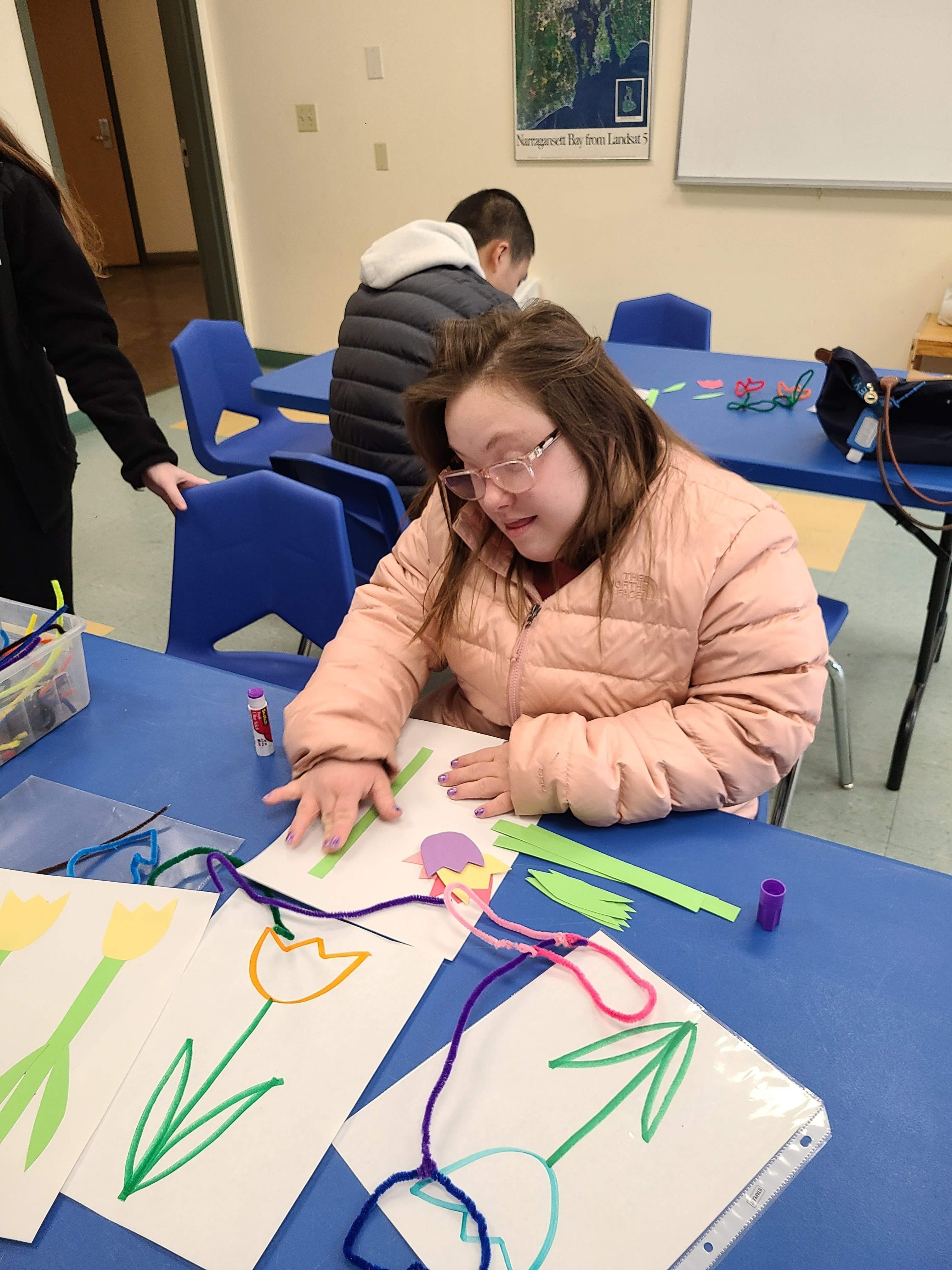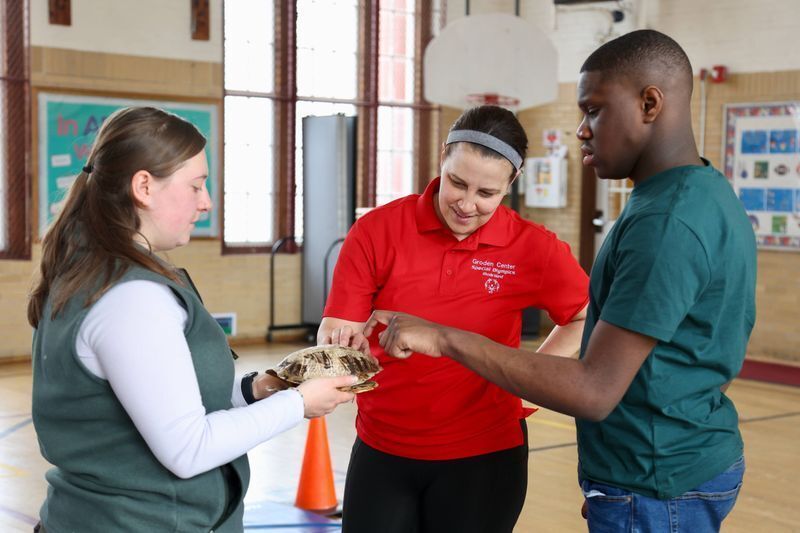
Published June 8, 2023
Amplifying the Quiet Voices: Audubon Launches Taking Root, an Inclusive Education Initiative
By Betsy Sherman Walker
_
April 2025 Note: Although Kate Swain no longer works for the Audubon Society of Rhode Island, we are grateful for her expertise and assistance in establishing our Taking Root program!
-
It has been a year since Audubon Educator Kate Swain and Senior Director of Education Lauren Parmelee embarked on a new initiative, “Taking Root: Nature-based Learning for All.” This pilot program aims to fulfill Audubon’s mission of connecting all people with nature—in this case, specifically students with special needs. With input from teachers, parents, and the students themselves, the end goal is to develop a well-funded, robust, barrier-free program that will serve students throughout the state.
“Today we are going to take a little hike,” Kate Swain announces to the eight high school students who have gathered around her at Powder Mill Ledges Wildlife Refuge in Smithfield. It is a bright Wednesday morning in late March with a wintery nip in the air, and the treetops are just beginning to thicken with buds. “We are going to explore habitats,” she tells them, “the fields and forests, and learn about the animals that live there. We take care of this land, and that includes the birds and the plants you will see.”
“We are still very much in the development phase of this program,” she said when we met at the Nature Center and Aquarium in March. “Our mission is to make these programs as available and as all-inclusive as possible. We don’t want to turn any kids away.”
The concept for this program was launched in March of 2022, when Swain received a call from Jessica Rawnsley, a special education teacher from Seekonk High School who works with students in the STARS program (Students and Teachers Achieving Results). Rawnsley had recently taken her nine-year-old son and a friend to the Nature Center and Aquarium in Bristol. “They had such a great time,” she said. With her own students in mind—she works with 14 to 18-year-olds whose cognitive levels range from pre-kindergarten to second grade—Rawnsley came away wondering if there were any programs or activities available at Audubon for her students. “My primary role as a special ed teacher,” she explained, “is to help [my students] integrate into the community. I thought, ‘I’ve got to get these kids out there.’”
“She told me she had six students at the high school with pretty significant intellectual challenges,” Swain said, “and that she wanted them to be able to experience a field trip.” To prepare for their visit, Swain teamed with Maloney and together, they tweaked the concept of “Nature Detectives,” a popular elementary school science program that is often the go-to for science educators. In April 2022, Rawnsley brought her high schoolers to Bristol for a nature walk. The topic was the change in seasons. Swain told them to be on the lookout for signs of spring, and off on the trails they went.
One need only look at the exuberant grins and the fist bumps in Rawnsley’s photos from that day to see that the visit was a huge success. Afterward, in understated wonder, the students recorded their reactions in their journals. “When I went to the Audubon Society for a field trip,” wrote one, “I had so much fun! We went for a nature walk and learned about different animals and where they live in the wild.” Another wrote as well about connecting with wildlife. “I had a fun time at the Audubon Society. We learned about a lot of animals and where they live.”
At the time, Swain recalls, “there were random groups of students with special needs visiting the Nature Center, and when they did come, things were a little bit chaotic and unstructured.” In essence, there was no formalized program or curriculum for students with disabilities. Swain, Maloney, and Parmelee found themselves in unchartered territory. They soon discovered that parents and school-based special educators were a valuable resource of personal experiences, advocacy, and contacts, and revealed a subculture of caregivers and children eager to get out there and experience nature.
Swain began to reach out to schools and teachers, those that educated students of all ages with disabilities. In November, a group from the Grace School in Providence (a pre-K through grade 8 school affiliated with Meeting Street School) came for a geology field trip. In the mix were two children using wheelchairs. The outing typically involves “going outside and digging in the dirt,” said Swain. Everyone adapted. “What we did was put a lot of dirt in a plastic bin. We brought it to the students and put the bins on their laps. Just getting their hands dirty, that experience, was a big deal.” Again, she took her cues from the students.
“It solidified my determination,” she recalls. “I thought, ‘we can do this.’”
“It came to a point when we finally said, ‘we’re going to pilot this program,’” confirmed Parmelee. “We saw an opportunity for Audubon to really engage people—and their caregivers—with the challenges at hand. It’s not just one person [we are serving],” she adds “Whole families are involved.”
“Our job,” Parmelee says, “is to open the door."
Parmelee is always searching for funding. “My passion is very involved in guiding the process,” she says. As Audubon’s grant writer for education initiatives, she must find compelling arguments with which to build her case. For “Taking Root,” she says, there were a number of lightning rods. There was the impetus to complete the 2020 Strategic Plan’s commitment to diversity and inclusivity. There was the impetus of Reed’s $100K grant money. And there was the impetus of Swain’s commitment and motivation.
Added to this was a generous gift from long-time Audubon supporter Mary Ann Cofrin, who has supported other Audubon programs that encourage inclusivity and outreach to underserved communities. “People with disabilities often do not have access to nature,” Cofrin said. “I strongly believe this program will not only enhance lives, but provide a unique opportunity to engage more people in the importance of environmental sustainability. This is a win-win for both the environment and those who might otherwise miss out on the joys of the natural world.” Her support will speak volumes for those whose voices aren’t always heard.
There was also another push to start this program, a personal one. The mother of an autistic child enrolled in a year-long residency program at Exeter House was a friend of Maloney’s who felt strongly about the benefits her child received from spending time in nature. “She is a strong and assertive parent—and has every right to be,” says Parmelee. This determined mother provided the human face of the need for a nature-based program for students with disabilities. She saw the rewards first-hand. “We had a mom pushing for this program, stressing the need for exposure to nature, and in turn we were looking to further our goals of inclusivity.” Everything clicked. “We said, ‘OK—let’s try it.’”
It is yeoman’s work, but the rewards run deep. Ginger Brown, a biologist and environmental science educator, is an ardent advocate for the pairing of those with cognitive, social, and emotional challenges with the wonders of nature. Since 2013 she has been working, on a weekly basis, with a group of young adults enrolled in Bristol’s non-profit L.I.F.E. program. The acronym stands for Living In Fulfilling Environments, and its mission is to normalize life’s experiences for the intellectually disabled. Parmelee calls it a “collaborative enterprise,” with L.I.F.E. providing the funding and Audubon the resources and classroom space at no cost. “Nature is less available to people with disabilities,” Brown says, “and I appreciate the opportunity to interpret nature for them.”
Brown’s coterie—she refers to them as her “citizen-scientists”—are curious and confident. They are currently monitoring Ospreys for Audubon and in May, they will be tracking the population of a colony of Purple Martins at Jacob’s Point in Warren. On a recent Wednesday at the Audubon Nature Center, Brown et. al. had spent the morning at Red Maple Swamp in Seekonk, behind the Home Depot. They had returned to the classroom, as they always do, for lunch and a debrief. Students tallied up the different species of birds they had spotted, discussing and making entries in their journals. In particular, this morning they observed the prenatal activities of Ospreys and Great Blue Herons. Since it is early April, Brown’s questions tend to focus on bird-breeding behavior. “What did we see in their beaks?” she asks. “It looked grassy, right? Nesting materials—adults flying to and from nests. They are lining the nest—making it soft for their babies.”
The self-appointed scribe of the group sets up a whiteboard, grabs a couple of dry-erase markers, and begins, in meticulous fashion, to list the many birds they saw. The final tally: 28. As they discuss the birds, Brown reminds them, “Everything this time of year is about bringing up the family.”
“I feel strongly that, to a person, being in nature is extraordinarily beneficial,” Brown explains. She and Mary Ann Cofrin are preaching from the same pulpit. “The people I work with have a real sensitivity to beauty.” On a recent field trip with her group, she added, someone observed that an Osprey in flight was waving at them. “They see the beauty. That makes my day.”
“Ginger has a wonderful relationship with her students,” says Parmelee. “She has great perspective. It’s not Us and Them. It’s We.”
For Swain, the next step includes training for Audubon staff to look through the students’ lenses for cues and clues – as she has done. “A big part of the pilot program is learning to be flexible and adapt as needed for each group of students,” she says. “In these kinds of programs, we need to have the skills to modify the programs to meet each student’s needs.”
For most of the group on the Powder Mill walkabout, it has been a compelling, successful encounter with the sights and sounds—and realities—of nature (two people even slipped in the marshy mud) and the circle of life. At the end, the buzz of curiosity continued with even more questions and comments. Universally, finding things out—making connections to the world around us—is powerful.
With the input and insight of everyone involved, Audubon is focused on amplifying this chorus of quiet voices. The student who wanted to know if the butterflies and turtles were real continued to keep Swain on her toes. He then wanted to know why there weren’t as many animals as he’d expected out on the trails that day.
“It’s the time of year, too early for some animals to be out,” was Swain’s response. “And they might have been hiding, as they could hear us coming.”
And somehow, for these newly-minted nature detectives, that was explanation enough.
Betsy Sherman Walker is a Rhode Island native who writes for area non-profits, news, and lifestyle publications, and who has recently discovered the joy and wonder of birding. Touch base at walkerbets@gmail.com.





















